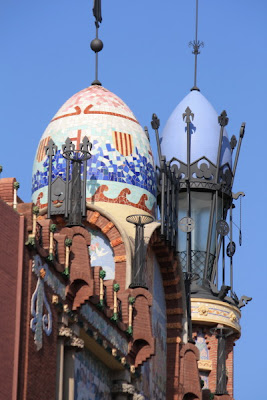The last two days of our trip were filled with an eclectic set of sights.
We spent the night after our second Aigüestortes hike in La Seu d'Urgel , where we found a very good Catalan restaurant - no pictures, but very good rap (Pat says it is her favorite fish) and excellent butifarra to rival that in Vic!

Afterward, wandering around town, we found that a rally was stopping in town overnight before heading out for the second day of racing, and the cars were parked on a Rambla

. Among them were a couple of old BMW 2002's, a model I owned decades ago when I was in graduate school.
The next morning we went to see the cathedral for which La Seu d'Urgell is named - "seu" means cathedral in Catalan. Begun in the 12th century, the facade and west front portal is quite severe.

The sculptured creatures left and right

above the portal illustrate the unhappy fate awaiting the unfaithful.
Sculptural detail high above the portal.


The back of the cathedral, with its unusual arched gallery circling the aspe, on market day.
Also visible behind the cathedral is an even older part of the complex: the

Iglesia de Sant Miquel, which was built in the 11th century.
Inside are the cloisters.


From La Seu d'Urgell we drove east out of the mountains to the Mediterranean - Cadaqués on the Cap de Creus peninsula just south of the French border. It was a small, isolated fishing village until it was "discovered" by Dali, Picasso - and then by tourists. But it is still very picturesque (see below).


We spent night at nearby Roses at a very nice hotel on the Mediterranean waterfront. Pat especially enjoyed our balcony view!

The next morning we visited the third of the great Catalan monasteries on our route: Monastir de Sant Pere de Rhodes on the Cap de Creus. It is older than the monasteries of Santes Creus and Poblet that we visited at the beginning of the trip: Sant Pere monastery is mentioned in documents from the 9th century and there is archaeological evidence of a large building on the site (whose purpose is unidentified) as early as the 6th century. From the 10th through the 13th century the monastery commanded great political and spiritual power, controlling land in what is now northern Spain and southern France.
Sant Pere sits high on a hillside above the Mediterranean; the weather was clear that day, but the breeze rising over the hillside created fog that floated across the monastery throughout our visit.


The austere and impressive church was begun in the late 10th century, consecrated in 1023, and finished by the middle of the 11th century. The high barrel vault of the central nave, and the arches separating it from the lateral aisles, are supported by an unusual system of columns - the vault rests on columns which in turn rest on lower sets of columns.


The columns are topped with corinthian capitals.

Two towers sit at the front the monastery: a 12th century bell tower and a defensive tower built slightly later - the monastery needed defense against attacks of pirates and bandits, and later against invading French troops. The inside of the bell tower.

We next headed south, toward Barcelona, but we had one more stop. When we visited the Museum of Catalan History in Barcelona, a display described the ruins of Greek and Roman towns on the coast at Empúries, a short way south of Roses.
With few expectations, this was the biggest surprise of our trip. There were extensive archaeological excavations of a substantial Greek town founded in the 6th century BC - the only Greek settlements on the Iberian peninsula whose location as been identified. Since it was a trading town, it sits right on the coast.



A hundred meters further up the hill are ruins of a town the Romans built in the 3rd century AC during the Second Punic War. Among these ruins are those of two large houses, with mosaic floors.

A couple of hours later we were back in Barcelona, having completed our "farewell tour" of Catalunya.
 A year in Barcelona had metamorphosed into memories. Visits of family and friends. Trips to Córdoba, Granada, and Sevilla in Andalusia; around Catalunya to hike in the Pyrenees, and visit monasteries and small churches; and to southern France for Thanksgiving with Pat's Missouri high school classmate. The trip back to the U.S. for Alan and Meredith's wedding. Visits to the Romanesque art at MNAC, and to the small chuches for which it was created. Monasteries and churches around Catalunya. Concerts at Palau de la Música Catalana. Santa Maria del Mar, the Plaça del Rei. Doménech's Hospital de la Santa Creu i de Sant Pau; Gaudi's Park Guell, Casa Batlló, and Sagrada Familia; Puig's Les Punxes. Barça's Tres Copes season and games at Camp Nou. Wonderful meals at restaurants around Barcelona and wonderful fruits and vegetables. Castellers. Walks along the Passeig de Sant Joan and through Gracia.
A year in Barcelona had metamorphosed into memories. Visits of family and friends. Trips to Córdoba, Granada, and Sevilla in Andalusia; around Catalunya to hike in the Pyrenees, and visit monasteries and small churches; and to southern France for Thanksgiving with Pat's Missouri high school classmate. The trip back to the U.S. for Alan and Meredith's wedding. Visits to the Romanesque art at MNAC, and to the small chuches for which it was created. Monasteries and churches around Catalunya. Concerts at Palau de la Música Catalana. Santa Maria del Mar, the Plaça del Rei. Doménech's Hospital de la Santa Creu i de Sant Pau; Gaudi's Park Guell, Casa Batlló, and Sagrada Familia; Puig's Les Punxes. Barça's Tres Copes season and games at Camp Nou. Wonderful meals at restaurants around Barcelona and wonderful fruits and vegetables. Castellers. Walks along the Passeig de Sant Joan and through Gracia.






















































